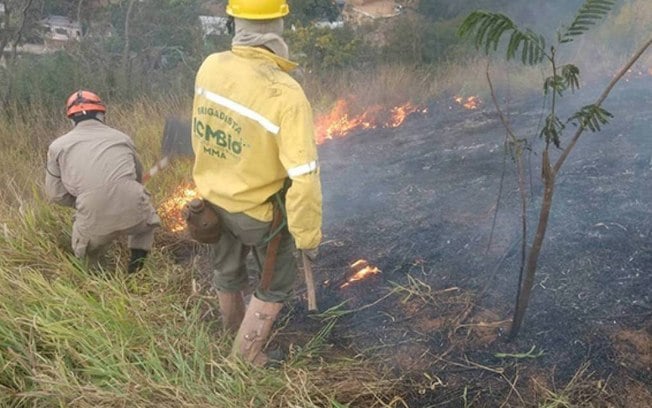The Pantanal region is experiencing a critical situation this year, with the fire season coming early and drought reaching worrying levels. In the states of Mato Grosso do Sul and Mato Grosso, the number of fire outbreaks skyrocketed in the first six months of 2024, increasing by 1025% compared to the same period of the previous year. Meanwhile, the Paraguay River, vital to the biome, is facing a historic drought, with its level currently more than 2 meters below average.
Mato Grosso do Sul, which is home to most of Brazil’s Pantanal, recorded 698 fires between January and June 2024, compared to just 62 in the same period last year. In neighboring Mato Grosso, the situation is no less worrying, with 495 fires in 2024, compared to 44 in 2023. This totals:
- 2024: 1193 fire outbreaks between January 1 and June 7;
- 2023: 106 fires between January 1 and June 7.
The data, released by the National Institute for Space Research (INPE) Database Program, show that this is the second highest number of fires in the region since 2010, behind only the devastating year of 2020, when fire consumed about 4 million hectares, equivalent to approximately 26% of the biome.
Experts explain that the burning season in the Pantanal, which normally occurs between July and August, can extend for up to six months due to the anticipation of fires and early drought.
In Corumbá, one of the main cities in the Pantanal of Mato Grosso do Sul, the lack of rainfall has lasted for more than 50 days, according to local meteorologists. With wildfires and air humidity falling, a dense layer of smoke blankets the region.
Last week, due to the imminent risk of fire and intense smoke, authorities evacuated children from a riverside school in the area, and classes were suspended for 10 days.
The Fire Department, which has been working in Operation Pantanal since April, announced that it managed to control the fire in three state parks in the region: Pantanal do Rio Negro, Nascentes do Taquari and Várzeas do Rio Ivinhema.
The lack of rainfall is also impacting the Paraguay River, the biome’s main watercourse. The level of the river in Ladário, a city near Corumbá, has been stable for about a month, and is currently 2 meters and 47 centimeters below the historical average.
Climate projections for June indicate continued drought and low humidity, which increases soil vulnerability to fires. On May 13, the National Water and Sanitation Agency (ANA) declared a “critical situation of scarcity” in the Paraguay River basin, a measure that will remain in force until October, given the worrying scenario and the significant reduction in the water level throughout the river.
The ANA statement pointed out that “the water level of the Paraguay River in April of this year reached the worst historical value observed in some monitoring stations along its main channel, and the scenario of scarcity has occurred since the beginning of this year in the Hydrographic Region of Paraguay.”
In addition to the losses to the environment, the scarcity of the river is already affecting other sectors of society. ANA listed the problems caused by the low level:
- Impacts on water uses, especially in water supply abstractions – especially in Cuiabá (MT) and Corumbá (MS);
- Impediment in navigation;
- Low run-of-the-river hydroelectric projects (in them, the flows that arrive are practically the same as those that leave the reservoirs);
- Complication for fishing, tourism and leisure activities.
-
The
declaration of an emergency by the National Water and Sanitation Agency (ANA) for the Paraguay River, scheduled until October 31, reflects a worrying outlook in the Pantanal biome. The World Wildlife Fund (WWF) has issued a warning about the alarming escalation of fires this year, describing the 2024 figures as the worst since the devastating period of 2020.
According to INPE monitoring, 2020 recorded the highest number of fire outbreaks in the Pantanal since the late 1990s. A study by 30 researchers estimated that, in that year, at least 17 million vertebrate animals were direct victims of the fires in the region.
Recent ANA reports indicate that Mato Grosso do Sul and Mato Grosso are already facing a drought situation, leading to the inclusion of the Pantanal at environmental risk by the Union since April. The state government of Mato Grosso do Sul responded with a “State of Environmental Emergency” decree in April, implementing strict measures to contain the spread of the fires, including restrictions on controlled burning and the hiring of temporary staff to meet emergency demands.
The cooperation between the state governments of Mato Grosso and Mato Grosso do Sul, together with the federal government, was formalized in a term of defense, protection and sustainable development of the Pantanal. The Minister of Environment and Climate Change, Marina Silva, proposed the elaboration of a pact for the Pantanal, involving not only the governors, but also the mayors of the region, in a joint effort to address environmental challenges.
Despite the preservation initiatives, deforestation in the Pantanal, although marked by ups and downs, registered a drop of 9% between August 2022 and July 2023, as pointed out by the latest annual report of the Project for Monitoring Deforestation in the Legal Amazon by Satellite (Prodes), while in the Amazon the reduction was even more significant, reaching 21%.
-
Want to stay on top of the day’s top news? Click here and join our WhatsApp channel
